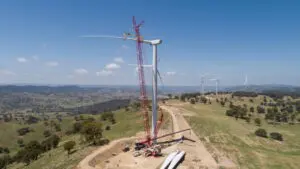The British government has bumped up the strike price for offshore wind in its renewables auction scheme by up to 66 per cent, following a series of dramatic exits from proposed projects because of rising costs.
The government overnight set a new ceiling of £73/MWh ($A139/MWh) for fixed bottom offshore wind projects and an eye watering £176/MWh ($A337/MWh) for floating offshore wind projects.
The government said it had decided to hike the maximum strike price by 66% for offshore wind, previously set at £44/MWh ($A84), and by 52% for floating offshore wind, previously set at £116/MWh ($A222), ahead of the next auction round in 2024.
“This will help ensure projects are sustainably priced and economically viable to compete in [Auction Round 6],” a government statement said on Thursday.
The government said offshore wind would also be given a “separate funding pot” in the upcoming auction round (AR6) in recognition of the high number of projects ready to participate.
“This will ensure healthy competition among a strong pipeline of projects, helping the UK deliver on its ambition of up to 50GW of offshore wind by 2030, including up to 5GW of floating offshore wind,” the statement says.
The move to put a more realistic value on the cost of developing offshore wind in the UK comes after the government’s most recent auction round, earlier this year, essentially priced the sector out of the bidding entirely.
This should not have been a surprise, with the cost of projects reported to be soaring around the globe, partly due to the impact of global events on supply chains and partly due to unrealistically low prices being set in the first place.
Certainly, the signs have been there. In July, one of the world’s biggest proposed offshore wind projects, Vattenfall’s Norfolk Boreas in the UK, was shelved by its developer due to spiralling costs.
Sweden’s Vattenfall said at the time that continuing the 1.4GW project at the low ball bid it had made several years earlier “simply doesn’t make sense” due to a 40 per cent increase in costs and a spiralling cost of capital.
In the same week in the US, a unit of Spain’s Iberdrola cancelled a contract to sell power from a planned project off the coast of Massachusetts, while Danish developer Orsted lost a bid to supply power to Rhode Island, due to costs now being much higher than the prices bid.
Still, the decision by the UK to make such huge upward adjustments to offshore wind pricing – particularly in the case of floating wind projects – sends a stark warning to countries like Australia, where the market for offshore wind is only just taking shape.
In particular, for Australia, it raises the question of whether floating offshore wind – likely to be used in NSW because of the continental shelf – is viable in the current market, when onshore wind and large-scale solar are so much cheaper to develop.
That said, for countries like Australia and the UK that are scrambling to replace fossil fuels on their grids and avert dangerous global warming, offshore wind is considered to be a crucial part of the mix.
In a statement on Thursday, British energy security secretary Claire Coutinho was keen to refresh memories on the successes the UK has already banked in offshore wind, such as hosting the world’s five largest projects, including the massive Dogger Bank.
“We recognise that there have been global challenges in this sector and our new annual auction allows us to reflect this.
“This is a vital part of our plan to have enough homegrown clean energy, bringing bills down for families and strengthening our energy independence,” Coutinho said.
RenewableUK chief Dan McGrail welcomed what he described as a demonstration that the government is intent on remaining a global leader in offshore wind.
“There is the potential for the government to attract a record level of private investment in offshore wind projects next year, with at least 10 projects likely to be eligible, able to power 8.5 million homes each year and reduce the UK’s need for gas by 39%,” McGrail said.
“The framework they’ve set out today is a significant step forward in securing this. Although renewables haven’t been immune from the recent rises in financing and supply chain costs which all major infrastructure projects have faced, they remain the lowest cost means of generating new electricity.
“Even at these new prices, there is still no cheaper way to meet the UK’s rising electricity demand and increase our energy security,” he said.
Emma Pinchbeck, Energy UK’s chief executive, said offshore wind was the “flagship technology” for the UK to meet its net zero targets and ensure energy security.
“We very much welcome the government responding to the increased global competition and the economic challenges facing developers by showing more ambition and giving greater confidence to investors, which will help build a domestic green powerhouse that benefits our own economy and people,” Pinchbeck said.






